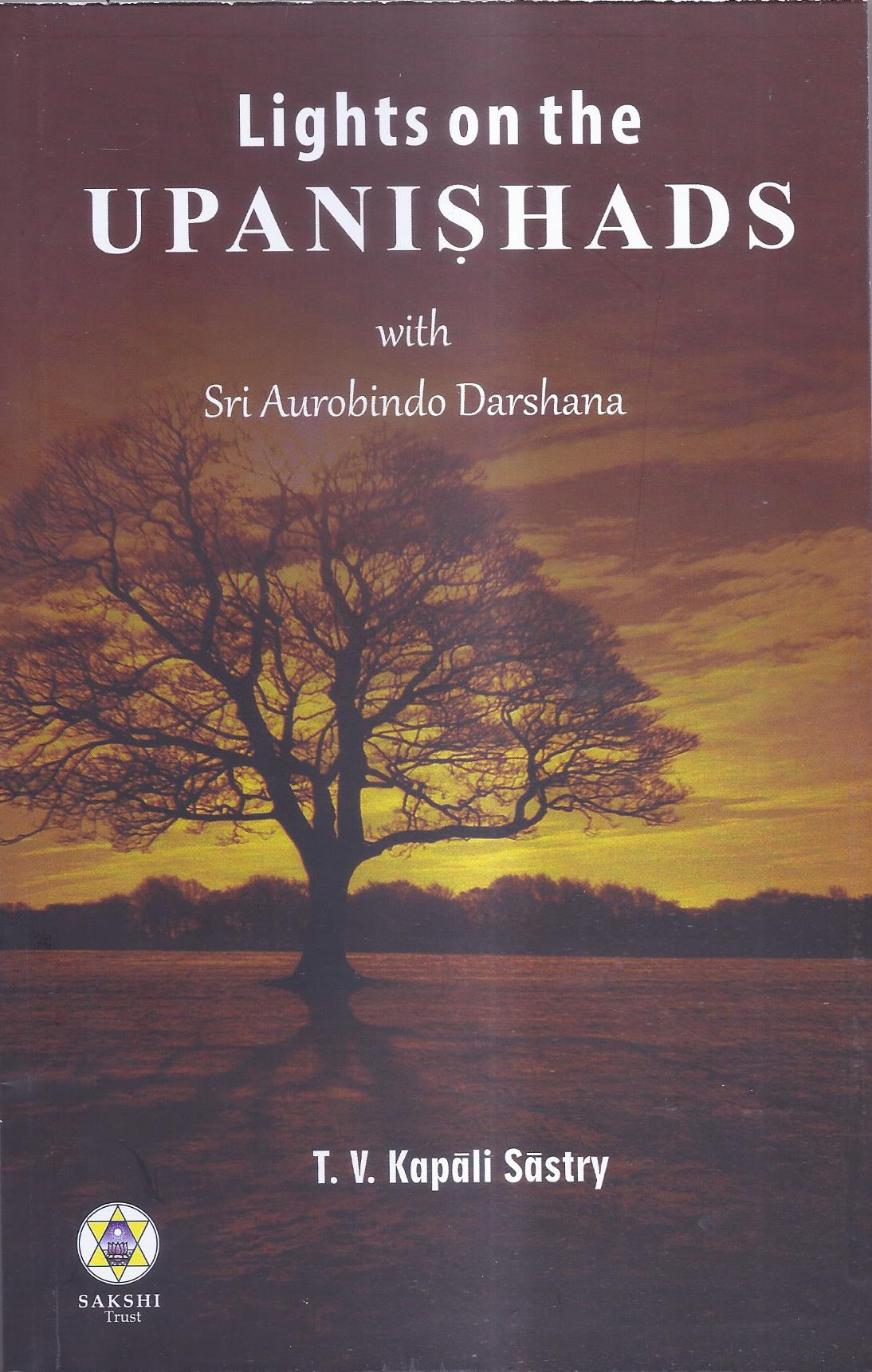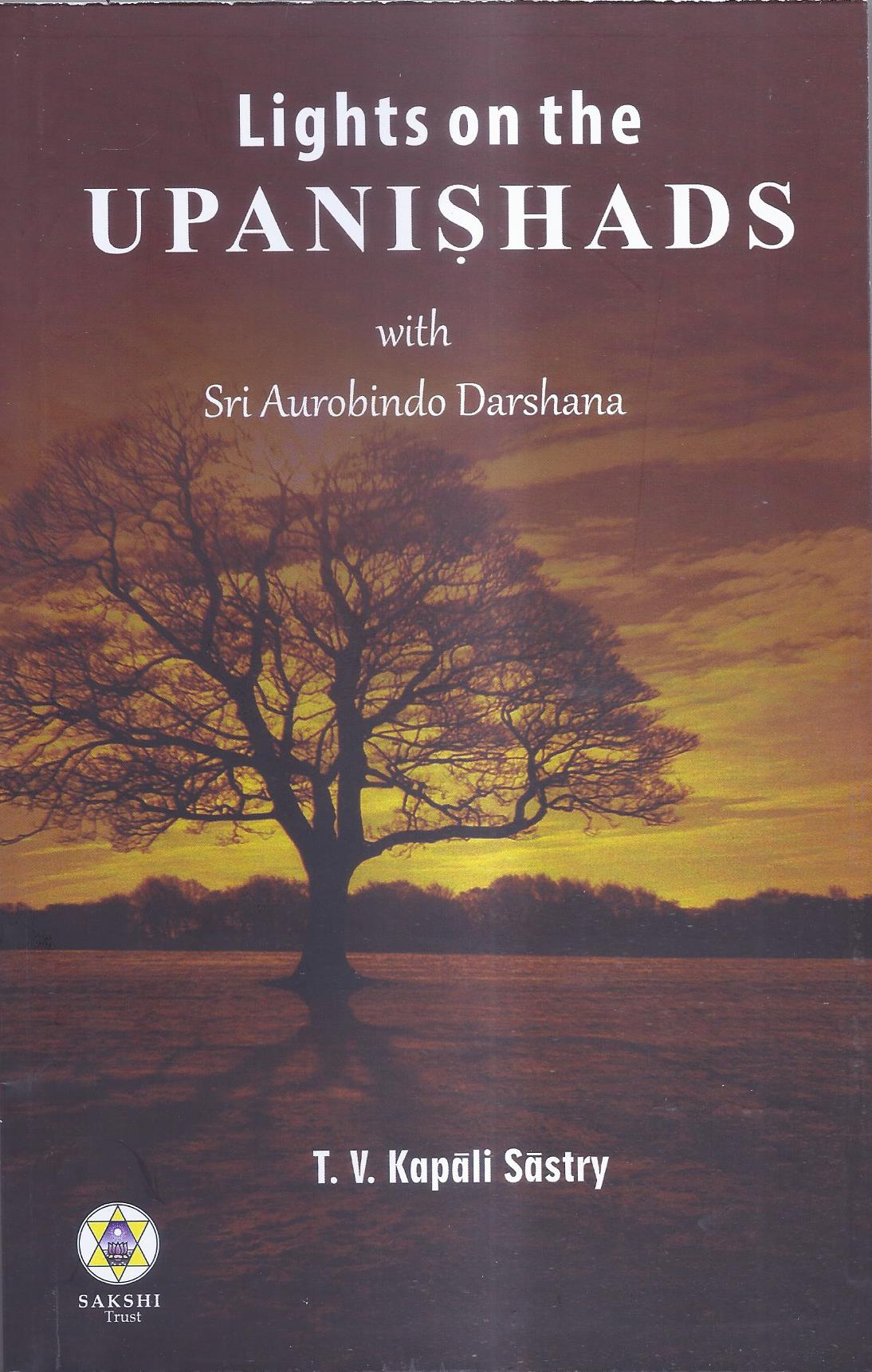Back of the Book:
Lights on the Upanishads
It has become a practice to see the contents of the Upanishads purely from and intellectual viewpoint. According to the seers of the Upanishads, the truths in these books should be realized by every individual.
The process of realisation is termed as Sadhana. The Upanishads are manuals of Sadhana. The hints on Sadhana are called as vidyas. 'Lights on the Upanishads' contains a detailed discussion of the six vidyas.
Within the purview of the Six vidyas discussed here, Sri T. V. Kapali Sastry has hinted at several modes of consolidation of Sadhana. It will facilitate to Sadhaka to evolve himself to the stature whose range spreads from the mere materiality to the super human / super divine levels of the super consciousness.
Note to Readers
Dear Reader
We are pleased to present this new edition of, 'Lights on the Upanishads', by Sri T.V. Kapali Sastry. It has been out of print for quite some time; it is now available in print only as a part of the volume 1 of the Collected Works. The uniqueness of this book is that it deals with the practice of the spiritual truths.
Most of the books on Upanishads in print in English describe its contents purely from an intellectual viewpoint. However according to the seers of the Upanishads, the truths in these books should be realized by every individual. i.e., it is not enough to understand the key terms like atman or prana intellectually; these truths should be realized by a person. For instance, the Chhandogya Upanishad declares in (5.2.3) that, "if a realized person were to tell this (the truth of prana vidya) to a dried-up stump, sure, branches would shoot forth and leaves spring from it".
The process of realisation is termed as sadhana. The Upanishads do not give the details of Sadhana, they only mention a few hints. These hints are called as vidyas.
We may mention that the only help the sadhaka gets in learning about these vidyas is from the commentaries in Samskrt by the great teachers in Vedanta such as Sri Shankara, Sri Madhva, Sri Ranga Ramanuja. Sri Ramakrishna Math has published the English translation of the commentaries of Sri Shankara with word-to-word meaning of the Samskrt words.
This book gives a detailed discussion of the six vidyas, four from the Chhandogya Upanishad. We know of no other book which explains certain aspects of the ancient and voluminous Upanishad, Chhandogya, in such a great detail.
The author never aimed this book at the beginners. Some knowledge of the Sanskrit and of the Upanishadic thought of the great ancient teachers like Sri Shankara was regarded almost as prerequisites.
Obviously many readers without these prerequisites have been benefited by this book. Such readers have suggested that the book could be made more accessible to beginners, by giving some expository material, and by rearrangement of the sections, but retaining Sri Kapali Sastry's own words. This new edition is an attempt in this direction.
First we have reproduced the introduction by Professor K. B. Ramakrishna Rao to both the Upanishads and the contributions of Sri T.V. Kapali Sastry. It is the text of the Sri Kapali Sastry Memorial Lecture delivered by Professor Rao in 1985 in Pondicherry. These Lectures were delivered at the request of Sri Madhav Pandit, the great disciple of Sri Kapali Sastry. His lucid introduction is a great help to the reader. It may be noted that both Sri T.V.K. and Professor Rao are not with us today.
Next we have transferred all the quotations in Samskrt from the main body of the text to footnotes. The reader can get a good understanding of the book without having the knowledge of Samskrt or of Devanagari script.
Every chapter is divided into subsections with subtitles (assigned by us). Also we have made minor rearrangements in the text, transferring more specialized topics to appendices at the end of the chapters.
The chapter 6 of the original book has really two separate parts. The first part deals with the connection between Veda and Vedanta (or Upanishads). The second part deals with the Madhu Vidya proper.
The first part is clearly beyond the scope of a beginner, as the author of the note who read this book several decades ago can testify. Hence the chapter 6 in the old edition has been divided into two chapters, chapter 6 and 7. The chapter 7 is given the title of Madhu Vidya. Chapter 6 is entitled, 'Vedic Wisdom in the Vedanta'. We have also transferred to (the new) chapter 6 similar discussions from other chapters also.
Thus a beginner seriously interested in the six vidyas in the chapter1 through 5 and chapter 7 can get a good insight along with the introduction in Part A. To understand chapter 6, the introduction in Part A is also of great help.
There have been requests for the reference to a single book which is an introduction to Sri Aurobindo's thought referred in this book. In the part C of this book, we present 'Sri Aurobindo Darshana,' a short essay written by Sri Aurobindo in Samskrt. It was written sometime during (1910-14) in Pondicherry. The text was printed in the journal, 'Sri Aurobindo: Archives and Research', December 78. The journal has also an English translation due to Sri Jagannath Vedalankara.
We present the text in Devanagari and Roman script and its translation, phrase by phrase. It is exactly like and Upanishad having short pithy sentences and analogies reminiscent of the existing major Upanishads mentioned in this book.
Sri Aurobindo states that the foreign translators of the Upanishads and their Indian followers, 'seek to bring out the intellectual sense without feeling the life of thought vision and the ecstasy of spiritual experience'. He states elsewhere that his method is, 'to enter passively into the thoughts of the old Rishis, allow their words to sink into our souls, mould them and create their own reverberations in a sympathetic and responsive material - submissiveness, in short, to the Shruti." According to Sri Aurobindo, "the Chhandogya Upanishad is the summary history of one of the greatest and most interesting ages of human thought". But Sri Aurobindo never wrote in detail on the two ancient and voluminous Upanishads, Chhandogya and Brhadaranyaka.
We are happy to present the work of Sri T.V. Kapali Sastry in the light of the thought of Sri Aurobindo.
All the footnotes in a chapter are consecutively numbered. The same footnote number reference may be found in several places. If the reference to a footnote indicated by a number indicated in the text is not at the bottom of the relevant page, it means that it has occurred earlier in the chapter.
Introduction
Any one who takes up the book without the orientation of Sri Sastry's thinking, or more properly, with a background of the usual ideas prevailing of the Upanishads as philosophical treatises of the highest type reached ever in all the Vedic thinking or history, would find it cutting a different path. For, from the beginning till the end Sri Sastry's mind is pre-occupied with unlocking the symbolism of the Upanishadic 'vidyss", or with the motive of telling that the Upanishads besides being philosophical discourses are fundamentally manuals of sadhana, which the Vedic Samhita expects the aspirants to follow in their pursuit of the highest spiritual goal. The work, the Lights on the Upanishads, really begins with the last two chapters. The last but one opens out the doors to the understanding of the rest of the work. When one enters into the spirit of Sri Sastry's style of thinking and the method of handling the material taken up for individual study viz. the vidyas, the book turns out to be a very precious document for a spiritual assimilation.
In the course of six brilliant discourses (the seventh being the summary of all the previous ones) Sri Sastry introduces us to as many as six 'vidyas' - the bhums, the prans, the shandilya, the vsishvanara, The Nachiketa and the Madhu - occurring in three of the major Upanishads, the Chhandogya, the Katha and the Brhadaranyaka, and provides us with the keys to unlock the mysteries of the Upanishadic sadhatas. We have attempts made earlier by scholars2 to enumerate the number of vidyas mentioned in the Upanishads, the Brahma Sutras and the commentaries, running upto thirty-two to thirty-seven vidyss. But this aspect of enumerating is no pre-occupation with Sri Sastry, nor the purpose behind his elaboration of the chosen vidyas the same. He has selected a difficult path of going deep into each of the vidyas to show how they record the inner bond of the Samhita of the Veda and the Upanishads, which speak of them. He has an ecumenical methodology of drawing in sources spread over the Samhitas, the Brahmanas, the Upanishads and the Vedic and the Upanishadic commentaries to show that the one purpose of the time honoured Vedas is not to be naturalistic, or ritualistic or to be magical, as the great Sayana and the modern oriental scholars have assessed, but to be spiritualistic or adbyatmic in its highest sense; and that the Vedas represent a stage of spiritual achievement of the highest order. Contrary to the general opinion held by many that the highest was only realised by the Upanishadic thinkers, and they touched the apex of the Vedic wisdom, Sri Sastry, following the illuminative mentorship of Sri Aurobindo, has shown in his study that the Upanishads had the sole aim of showing that they are inalienably linked with the Samhitas, and are only a continuation of the spiritual seekings and any of their achievements are structurally one with the intuitions of the Samhitas.
But how the Upanishads gained rather an independent and special status, and a better one too, as the 'Vedanta', than the Veda Samhita itself, can be a significant question raised, for which an answer is outlined in a short but a graphic way. This section marks itself as a historical reconstruction, not on linguistic or philological basis, i.e., whether the Samhita reflects a more ancient or archaic form of Sanskrit than the one found in the Upanishads - the usual stand taken by evolutionists of language - but it is a reconstruction which restores the dignity and spiritual value of the Samhita. The reasons for making the distinctions that came to prevail in later times between the Samhita as Veda and the Upanishads as Vedanta need to be noted. The first distortion, according to Sri Sastry, occurs with Jaimini, the aphorist of the karma mimsmsa, who for purposes of strengthening the voice of his exoteric ritual treated the Samhita as preliminaries to Brahmanas, the ritualistic treatises, thus creating an artificial identity of a 'Karma Kanda' of the Samhitas and the Brahmanas. It was next left to Badarayana, the aphorist of the Vedanta Sutras, to put the Aranyakas and the Upanishads together as source material for his theory of, 'Jnana Kanda'. This became a standard understanding for centuries down of maintaining a distinction between the Veda (standing for the ritual) and the Upanishads (standing for jnana), and the elevation of the latter as peaks of spiritual achievements, an indispensable way of studying the spiritual history. Then came the Commentaries on the Upanishads and the Vedanta Sutras systematising the Vedanta (the path of knowledge) as against the Veda (the path of the ritual) - a distinction so venerably maintained down the ages.
What happened in this career was unfortunate to the very heart of Vedism or shruti tradition, viz. the relegation of the Samhita to a lumber room of archaic stockpile, with no appreciable significance for a spiritual growth. The commentators of Vedanta like Shankara- Acharya, and the later commentator of the Veda viz. Sayanacharya, consolidated this position, with the result that the modern studies of the Veda and the Vedanta stuck to this distinction as the most rational honourable way on any score. The Western mind found it to be very logical and understandable; and applied their tools of language, grammar and philology etc., to determine the 'antiquity' and therefore the 'crudeness' of the earlier Veda, the 'modernity' and therefore the 'refined' state of the Vedanta or the Upanishads. This 'evolutionary' technique appealed to recent thinkers also to be the safest standard for determining the historical portrait of the entire Vedic literature.
Sri Sastry points out, what passed beyond their comprehension was unfortunate, and it required the vision of Sri Aurobindo to restore the lost light of the Vedas, and to lay the foundation of a new line of historical cum spiritual reconstruction of the shruti - tradition. This was a heroic task - indeed a Promethean one, for by it the light or fire of the Vedic wisdom that was lost was brought back by the intuitive meditations of the Mahayogi Sri Aurobindo. It was made out by explaining the secrets of the Vedic symbolism. Not only the Samhita records a sense of spiritual realisation but also a technical perfection in the use of terms referring either to Vedic Gods or items of religious usage. Sri Sastry quotes from Sri Aurobindo: 'The Rishis put the substance of their thought in a system of parallelism by which the same deities were at once internal and external powers of universal Nature, and they managed its expression through a system of double values by which the same language served for their worship in both aspects. The psychological sense predominates and is more pervading, close knit and coherent than the physical.'
The purport of this emphasis by Sri Sastry on Sri Aurobindo's discovery of the esoteric and mystic/spiritualistic character of the Vedic Samhita was only to make sure that the Indian understanding of its own past should not again get lost in the dreary deserts of philological fantasy and a naturalistic fallacy, as it were, but sail through the clear springs and streams of divine courses and sometimes even inundating the parched hearts of the spiritual aspirants praying for the immortal grace of wisdom and peace. Any honest and genuine lover of the culture of the land would certainly welcome this yeoman service which has a parallel in none other than the legendary Bhagiratha's tapas bringing down the sanctifying Ganga.


